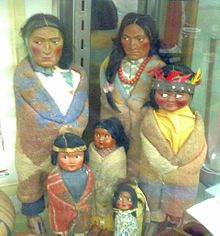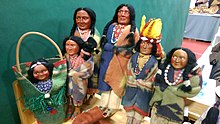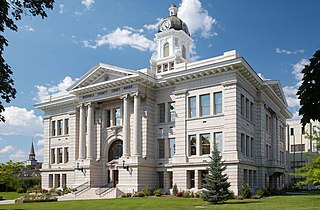
Missoula County is located in the State of Montana. As of the 2020 census, the population was 117,922, making it Montana's third most populous county. Its county seat and most populous city is Missoula. The county was founded in 1860.

A doll is a model typically of a human or humanoid character, often used as a toy for children. Dolls have also been used in traditional religious rituals throughout the world. Traditional dolls made of materials such as clay and wood are found in the Americas, Asia, Africa and Europe. The earliest documented dolls go back to the ancient civilizations of Egypt, Greece, and Rome. They have been made as crude, rudimentary playthings as well as elaborate art. Modern doll manufacturing has its roots in Germany, from the 15th century. With industrialization and new materials such as porcelain and plastic, dolls were increasingly mass-produced. During the 20th century, dolls became increasingly popular as collectibles.

A dollhouse or doll's house is a toy house made in miniature. Since the early 20th century dollhouses have primarily been the domain of children, but their collection and crafting is also a hobby for many adults. English-speakers in North America commonly use the term dollhouse, but in the United Kingdom and other English-speaking countries the term is doll's house. They are often built to put dolls in.

Mary Marvel is a fictional character and superheroine originally published by Fawcett Comics and now owned by DC Comics. Created by Otto Binder and Marc Swayze, she first appeared in Captain Marvel Adventures #18. The character is a member of the Marvel / Shazam Family of heroes associated with the superhero Shazam / Captain Marvel and is one of the first female spin-offs of a major male superhero, and predates the introduction of Supergirl by more than a decade.
Skookum is a Chinook Jargon word that has historical use in the Pacific Northwest. It has a range of meanings, commonly associated with an English translation of strong or monstrous. The word can mean strong, greatest, powerful, ultimate, or brave. Something can be skookum, meaning "strong" or "monstrously significant". When used in reference to another person, e.g. "he's skookum", it conveys connotations of reliability or a monstrous nature, as well as strength, size or a hard-working nature.
Florence Elizabeth Riefle Bahr was an American artist and activist. She made portraits of children and adults, including studies of nature as she found it. Instead of using a camera, more than 300 pen and ink sketchbooks catalog insights into her life, including her civil and human rights activism of the 1960s and 1970s. One of the many important captured events included the Washington D.C. event where Martin Luther King Jr. first gave his I Have a Dream speech. Her painting Homage to Martin Luther King hangs in the (NAACP) National Association for the Advancement of Colored People's headquarters. She created illustrations for children's books and painted a mural in the Works Progress Administration (WPA) for the Johns Hopkins Hospital's Harriet Lane Home for Children. Her works have been exhibited in solo and group exhibitions since the 1930s. In 1999, she was posthumously awarded to the State of Maryland's Women's Hall of Fame, as the first woman artist they recognized.

What's Her Face! was a line of customizable dolls that straddled the line between traditional fashion dolls and creative activity toys. Made by Mattel, the line ran from 2001–2003, and enjoyed only a modest success in a market dominated by Mattel's iconic Barbie and MGA Entertainment's Bratz dolls. Following the discontinuation of the What's Her Face! line, their body molds were used for the Wee 3 Friends line of Barbie-related dolls. Several fashion, wig, and activity packs were also released for the What's Her Face line.
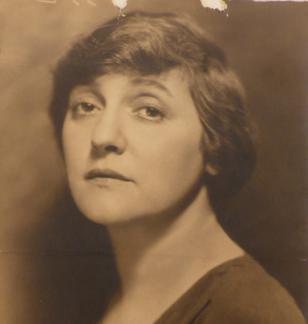
Aline Bernstein was an American set designer and costume designer. She and Irene Lewisohn founded the Museum of Costume Art. Bernstein was the lover, patron, and muse of novelist Thomas Wolfe.
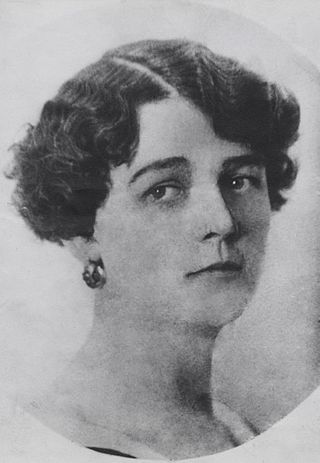
Varvara Jmoudsky, better known as Barbara Karinska or simply Karinska, was the Oscar-winning costumier of cinema, ballet, musical and dramatic theatre, lyric opera and ice spectacles. Over her 50-year career, that began at age 41, Karinska earned legendary status time and again through her continuing collaborations with stage designers including Christian Bérard, André Derain, Irene Sharaff, Raoul Pêne du Bois and Cecil Beaton; performer-producers Louis Jouvet and Sonja Henie; ballet producers René Blum, Colonel de Basil and Serge Denham. Her longest and most renown collaboration was with choreographer George Balanchine for more than seventy ballets — the first known to be “The Celebrated Popoff Porcelain,” a one act ballet for Nikita Balieff's 1929 La Chauve-Souris with music by Tchaikovsky for which Karinska executed the costumes design by Sergey Tchekhonin. She began to design costumes for Balanchine ballets in 1949 with Emmanuel Chabrier's “Bourrèe Fantasque,” for the newly founded New York City Ballet. Their final collaboration was the 1977 "Vienna Waltzes.” Balanchine and Karinska together developed the American tutu ballet costume[9] which became an international costume standard.

The Love Hurts Tour was the third solo concert tour by American singer-actress Cher. The tour supported her twentieth studio album, Love Hurts. The tour reached Europe and North America. It played in arenas and followed the previous Heart of Stone Tour.
Joyce Carlson was an American artist and designer credited with creating the idyllic universe of singing children at "It's a Small World" rides at Walt Disney theme parks around the world. Carlson also worked as an ink artist in the Walt Disney Animation Studios, on such films as Cinderella, Peter Pan and Sleeping Beauty. She was the lead ink artist for the 1955 Disney film Lady and the Tramp. She spent 56 years working on Disney's animated films and theme park attractions.
Albert Marque was a French sculptor and doll maker of the late 19th and early 20th centuries.
Hell Gate is a ghost town at the western end of the Missoula Valley in Missoula County, Montana, United States. The town was located on the banks of the Clark Fork River roughly five miles downstream from present-day Missoula near what is now Frenchtown.

An apple doll, also known as an apple-head or applehead doll, is a North American folk craft in which the doll's head is made from a dried apple. In modern times, apple dolls are mostly used as decorations or to display craftsmanship, rather than as children's toys. Because of the different effects drying produces, no two dolls are alike.
The following is a list of episodes from the fourth season of the PBS series, Mister Rogers' Neighborhood, which aired in 1971. It is the first season to premiere on PBS after the 1970 renaming from NET.
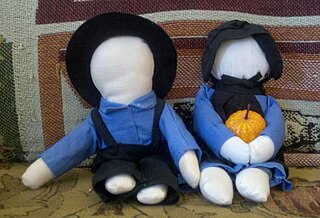
Amish dolls are a type of rag doll and a popular form of American folk art, which originated as children's toys among the Old Order Amish people. While some Amish dolls have faces, the majority of them do not, to emphasize the fact that all are alike in the eyes of God.

A Hero for a Night is a 1927 American silent comedy film directed by William James Craft and produced and distributed by Universal Pictures, cashing in on the "Lindy craze", generated by Charles Lindbergh's famous ocean crossing flight. The film stars Glenn Tryon, Patsy Ruth Miller and Burr McIntosh.
Marjory Fainges is an Australian researcher and historian on the subject of the Australian Toy Industry over the last 100 years in particular the commercial manufacture of dolls. She has written 16 books and is a doll judge of antique, collectible, modern and artist dolls and she has lectured internationally.
Debra Sparrow, or θəliχʷəlʷət (Thelliawhatlwit), is a Musqueam weaver, artist and knowledge keeper. She is self-taught in Salish design, weaving, and jewellery making.
Jusaburō Tsujimura was a Japanese puppeteer, puppet and doll maker, and art director.


